We were honored to have the chance to speak with three representatives from NOAA Fisheries Office of Protected Resources who are actively involved in the protection of sea turtles under the ESA: Angela Somma, Director, Endangered Species Division; Alexis Gutierrez, Foreign Affairs Specialist; and Barbara Schroeder, National Sea Turtle Program Coordinator.
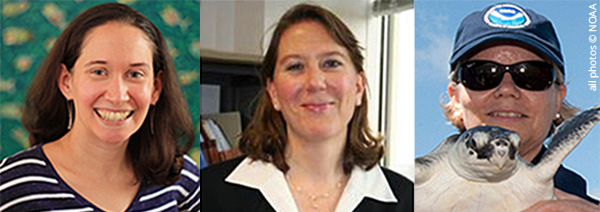
(l-r) NOAA Fisheries experts Alexis Gutierrez, Angela Somma, Barbara Shreoder
How does NOAA Fisheries share responsibility for the recovery and conservation of sea turtles under the Endangered Species Act?
Barbara Schroeder: Everything terrestrial—the nesting beaches where turtles lay their eggs, where eggs incubate, and where hatchlings leave the land to enter the marine phase of their life—is under the jurisdiction of the USFWS. Everything in the marine environment—which includes inshore bays and lagoons, nearshore waters, and offshore waters—is under the jurisdiction of NOAA Fisheries. The split is really land and water, but we work very closely with USFWS on all aspects of sea turtle recovery. We have joint recovery plans, we do joint status reviews, and on any significant actions, we work closely together to keep each other informed.
Can you give us an overview of the ways NOAA Fisheries implements the ESA (in general) once a species is listed?
Angela Somma: If a species is listed as endangered, there are a whole suite of protections and prohibitions that come into place. Everyone is prohibited from “taking” an endangered species. That includes not just killing or hunting, but harassing or harming, and it doesn’t matter if the take is intentional or unintentional. It also puts a special onus on other federal agencies to ensure that any action they authorize, fund, or carry out does not jeopardize an endangered species or adversely modify its habitat.
At the time we list a species, we are also supposed to designate critical habitat, and other federal agencies must avoid destroying or adversely modifying that critical habitat. Even scientific researchers are required to receive a permit from us. We evaluate the research they intend to undertake to make sure it will actually benefit the species before a permit is issued.
For non-federal entities that may take protected species incidentally there is a provision for us to provide them a permit to do so as long as they develop a conservation plan to minimize and mitigate the effect of that take. [There are monitoring and reporting requirements associated with such permits.] We have used that provision to address some of the state fisheries that have taken sea turtles and some of our listed fish as bycatch or incidentally taking them when they are targeting other species. Through the prohibition of federal agencies of jeopardizing listed species, we address federal fisheries outside of state waters to ensure that the levels of incidental take of marine species, including sea turtles, is at a level that does not impact their ability to recover.
If a species is “threatened” all of those prohibitions do not necessarily automatically come into place, but we have the ability—through regulations—to apply those same protections. For sea turtles, we have a regulation under Section 4D of the ESA, which includes all of the same protections for a threatened species as an endangered species.
Finally, we are required to develop a recovery plan for the species. Recovery plans bring together interested stakeholders to develop a road map for how the species will be recovered, and what goals, objectives, and necessary criteria are to determine that a species has recovered before it will be removed from the list. Every five years, we are required to review the status of listed species to make sure it is properly classified. Through that review, we do evaluate how well our efforts are achieving our recovery goals.
How are these regulations enforced?
Angela: NOAA Fisheries has an Office of Law Enforcement that can enforce violations of Section 9 of the ESA (where the prohibitions are), but in the case of incidental take, we often try to first work cooperatively with the industry or group to bring them into compliance and develop a conservation plan. In the end, that will get us to the best place in terms of recovery and minimizing the impact of their activity over the long term.
When there is enforcement, is the penalty usually in the form of a fine? Required mitigation?
There are civil and criminal penalties under the ESA.
In what ways does the Endangered Species Act protect sea turtles against the many human-induced threats they face? (How does the ESA translate to sea turtle conservation action? Any particularly powerful examples to share?)
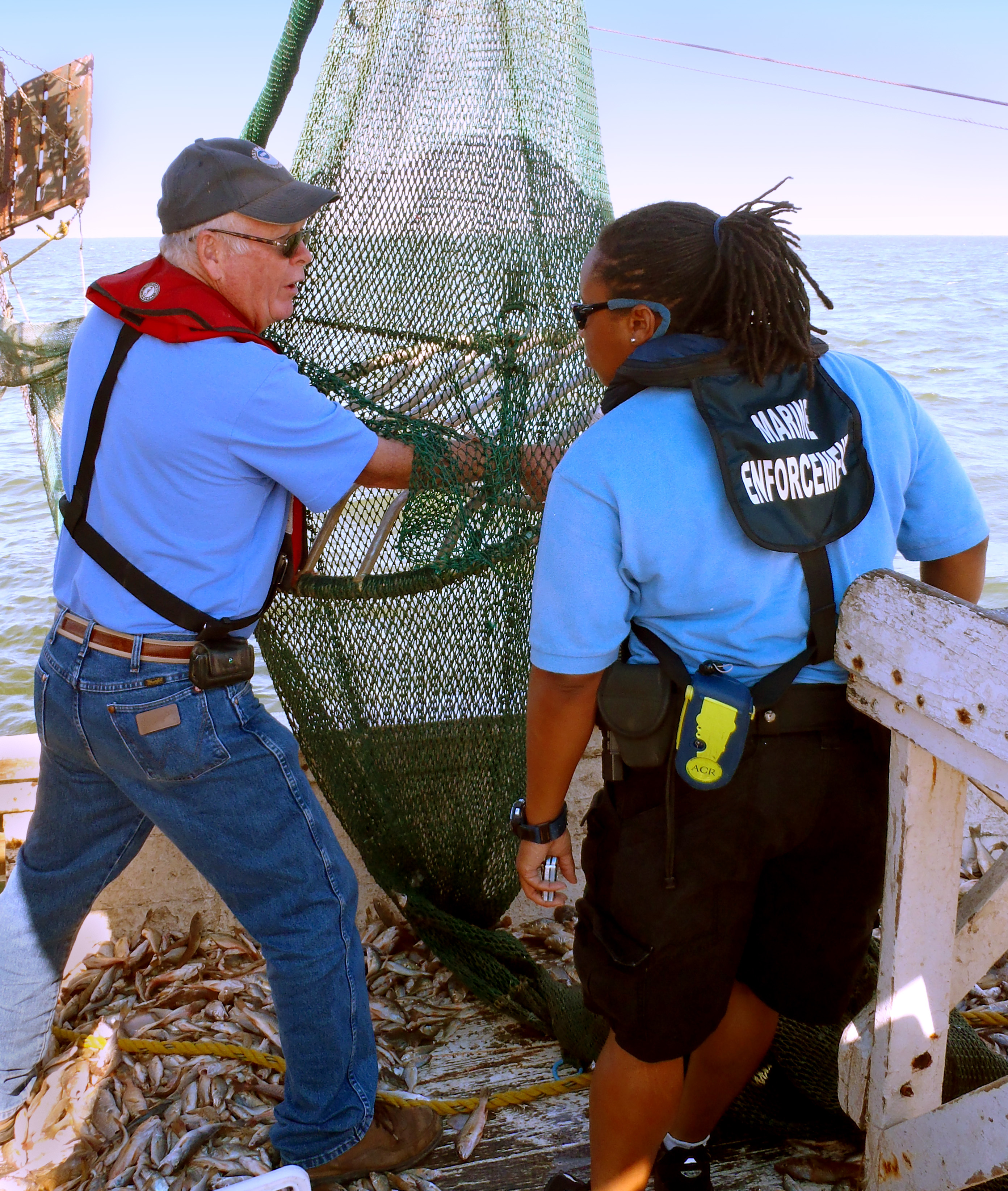
Measuring a Turtle Excluder Device, ©NOAA
Angela: There is very little anyone can do in the marine environment without some type of federal authorization. One of the greatest threats to sea turtles is fisheries bycatch. In the US EEZ [Exclusive Economic Zone], under the Magnuson-Stevens Fishery Conservation and Management Act, federal fisheries are managed by NOAA Fisheries. Working within NOAA Fisheries’ Office of Sustainable Fisheries, we have been able to introduce [the prevention of] incidental bycatch of sea turtles into fisheries [management]. One of the greatest conservation success stories—not just for sea turtles, but under the ESA in general—is the requirement [which NMFS put into place] that all U.S. shrimp otter trawlers use a Turtle Excluder Device (TED), which allows sea turtles to escape. We also have a law requiring that any wild-harvested shrimp caught with an otter trawl and imported into the U.S. must be caught with a trawl that has a turtle excluder device installed; otherwise the shrimp cannot be imported. So that [TED] technology has since been exported to other countries.
[Development and design of the Turtle Extruder Device (TED) began in the early 1980s at NOAA Fisheries’ lab in Pascagoula, MS, which focuses on gear modification and research—not only to help protect listed species, but also to help reduce bycatch in general. The design was modified for more than a decade before. Click here for more on the history and required use of the TED.]
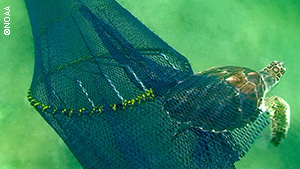
Loggerhead (Caretta caretta) escapes through a TED
For state fisheries that are not managed by the federal government we are able to use Section 10 of the ESA, a provision that allows us to work with them to develop a conservation plan to minimize the take of listed species. North Carolina, for example, has significantly reduced the impact of their state fisheries on sea turtles [though such a permit]. When sea turtles are nesting on the beach and under the jurisdiction of the USFWS, USFWS has worked with counties and other entities to prohibit people from driving on beaches, which has been a big issue in the south. Several counties in Florida now have lighting ordinances that require lighting to be directed a certain way so that it does not disorient sea turtles and their hatchlings.
NMFS also has a number of grant programs. We work very cooperatively with environmental organizations and other interested citizens. The ESA gives us a variety of regulatory and non-regulatory tools that have allowed us to significantly improve the status of sea turtles.
Earlier this spring, NOAA Fisheries and USFWS issued a final rule that revised the listing of green sea turtles under the ESA. It now lists 11 distinct population segments (DPS), eight of which are “threatened;” three of which are “endangered.” How does this new listing differ from the previous listing?
Angela: The ESA allows us to list species, subspecies, or distinct population segments. In 1978, when green sea turtles were listed, the provision to list distinct population segments was not in the ESA. Green sea turtles were listed as threatened rangewide, with the exception of two “breeding populations” which were determined to be endangered: the Florida breeding population and the western Mexican breeding population. Congress later amended the ESA to allow us to list DPSs, but at that time, we didn’t have a policy governing how we identified DPSs until later.
When we undertook this recent status review, we decided it was time to divide the species listing into DPS. That is what was done here: the breeding populations have now been subsumed into distinct population segments. The DPSs containing the Florida and the western Mexican breeding populations have been downlisted from endangered to threatened, given the success that we’ve seen over the last number of years. The Mediterranean DPS, the Central South Pacific DPS, and the Central West Pacific DPS are considered endangered now.
So rather than have a global listing with two subpopulations, we have now taken the species and divided it into 11 DPSs. For purposes of implementation of the ESA, a DPS is considered a species, so the effect is the same.
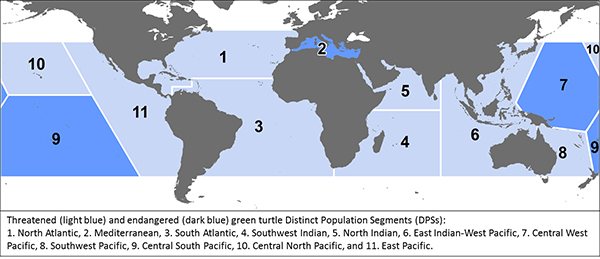
Courtesy of NOAA
To what do you attribute the downlisting of those two DPSs?
Angela: 1) Better protection on their nesting beaches, in terms of the nesting beach habitat itself, reduced harvest of adults laying eggs, and reduced harvest of eggs. 2) Significantly reducing fisheries bycatch in the marine environment. Those two things in combination have really set [those DPSs] on the right trajectory, moving towards recovery.
What distinguishes “threatened” from “endangered,” and how fine a line is that?
Angela: Within the ESA, an “endangered” species is in danger of extinction throughout all or a significant portion of its range. A “threatened” species is likely to become endangered throughout all or a significant portion of its range in the foreseeable future.
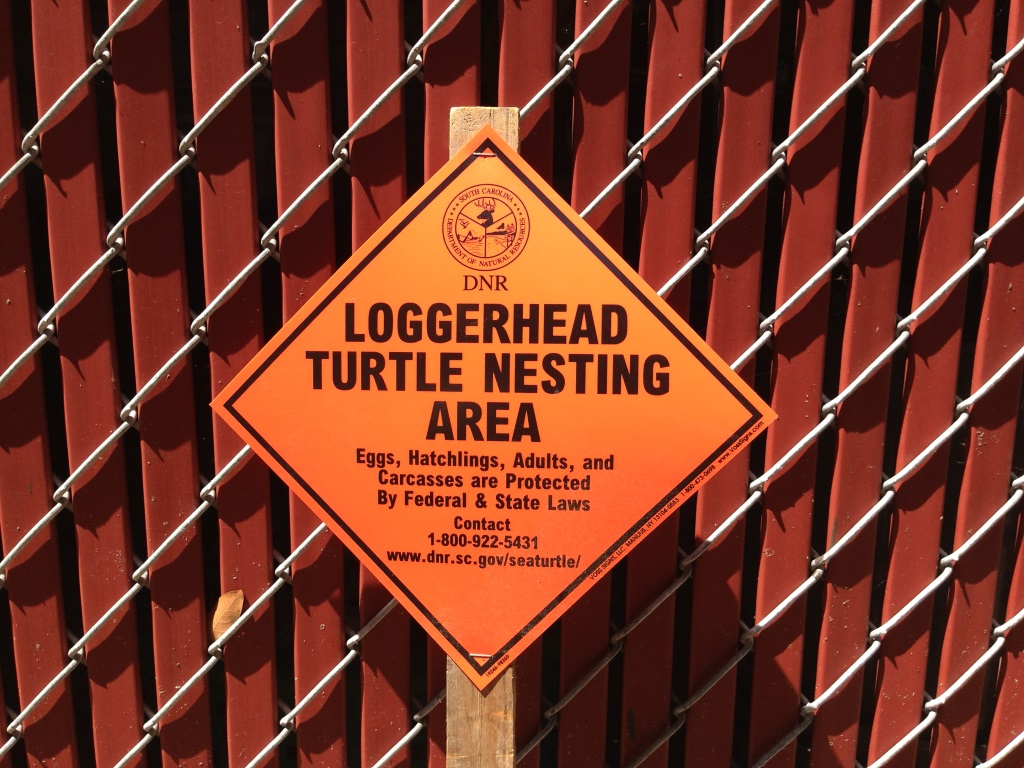
How will the revised green sea turtle listing impact conservation?
Angela: One of the reasons why we are identifying distinct population segments (we have also done this over the last several years with loggerhead turtles) rather than keeping these animals listed at the species level is that it can facilitate research and conservation by helping us better manage at the population level. When you have a globally listed species found in every ocean basin, it can be very difficult to try and assess your recovery progress. Whereas if you have DPSs, it can really help you understand what is going on with those particular populations, and allow you to better manage, through the provisions of the ESA, those populations.
Could there potentially be any negative impacts of this revised listing? Is there any risk that people will become less concerned about some of the downlisted species?
Angela: I don’t think there are any negative implications. [The revised listing] may be confusing to the public, because they tend to think of the sea turtles as sea turtles, or perhaps they think about them at the species level. So the idea of different DPSs being listed as endangered vs. threatened may be confusing to the public, but we think the conservation benefits outweigh any potential confusion.
With the green sea turtle listing and the loggerhead listing [which will be revised to reflect DPSs identified in 2011] the fundamental message is: we have been making progress, but all of the sea turtles are still at some risk of extinction, and none has quite recovered yet.
Eastern and western Pacific leatherback turtles are currently listed as critically endangered on the IUCN red list and I see that NOAA Fisheries highlights the Pacific leatherback among its “Species in the Spotlight,” saying it is “at risk of extinction.” What can you tell us about the Pacific leatherbacks’ recent and rapid decline?
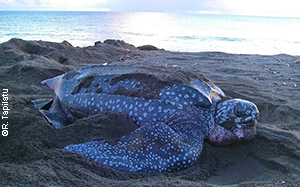
Leatherback (Dermochelys coriacea) nesting on Papua Barat
Alexis Gutierrez: In the western Pacific, leatherbacks nest in Indonesia, Papua New Guinea, the Solomons Islands, and Vanuatu. Historically, they nested in Malaysia, but that population is now extinct because there was mass overharvesting of eggs. 70% of Pacific leatherback nesting is now found along a 24-kilometer stretch of beach on Papua Barat in Indonesia.
What can you tell us about NOAA Fisheries’ efforts to try to stop the dramatic decline of Pacific leatherbacks?
Alexis: If you think about the geographic area stretching from the very edge of Southeast Asia to the edge of Chile [the Pacific leatherback range], the number of countries that are engaged [in Pacific leatherback conservation] is quite large. We have no nesting in U.S. territories, so we have to work bilaterally and multilaterally to encourage these countries to do the right thing. We work with foreign governments at the diplomatic level; we work with the NGOs and research institutions at the beach level; and we work with coastal fisheries to help them do rapid bycatch assessment and bycatch mitigation through new gear or new fishing practices. We have a long history of this kind of engagement, but with such a broad geographic area, we’re talking about working with multiple languages and governance structures.
We have built networks of partners in both eastern and western Pacific areas, but it will take a huge effort to stop the rapid decline and stabilize the populations. This is why we are highlighting Pacific Leatherbacks through our Species in the Spotlight initiative, so that we can continue to focus attention on the urgent need to stop this decline. We have identified critical recovery actions needed over the next five years in a five-year action plan.
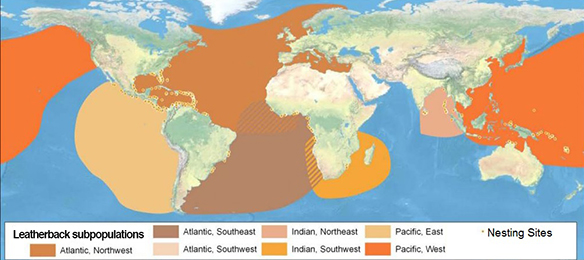
Global distribution of leatherbacks (Dermochelys coriacea) ©NOAA
When dealing with international efforts like this, what tools give you the most hope for progress in addressing the decline of Pacific leatherbacks? Do you find that you have more success working with local NGOs than, say, trying to enforce the commitments made by nations in different treaties?
Alexis: We have to do all of it. We need on-the-ground, grassroots activities, but we also need high-level government structure and commitment. NMFS was one of the leaders in negotiating the Inter-American Convention for the Protection and Conservation of Sea Turtles, the only international treaty in the world for sea turtles. We were also a critical part of the U.S. delegation to the Indian Ocean-Southeast Asian Marine Turtle Memorandum of Understanding. That is a nonbinding agreement that serves as a forum to foster cooperation in the Indian Ocean and Southeast Asian region.
Sea turtles travel such vast distances, and aren’t confined by national borders, so international cooperation seems critical for all sea turtle species. Can you share an example of an international conservation collaboration that has been particularly successful?
Alexis: One of the best examples has been our long-term collaboration with Mexico on sea turtle conservation and recovery. We have partnered with Mexico on the recovery of several species—Kemp’s ridley, Olive ridley, leatherbacks, loggerheads, hawksbills, and green sea turtles. In the case of Kemp’s ridley, we jointly wrote a Binational Recovery Plan for Kemp’s ridley and we have a Kemp’s ridley working group that facilitates on the ground conservation of the key nesting beaches in Mexico. Through this work, we have seen the species go from the brink of extinction to a slow and steady increase in number of nesting females. There are still several threats impacting the population, but the species is in a much better situation today than it was three decades ago.
For this issue, we also spoke with David Godfrey of the Sea Turtle Conservancy, about an effort to protect and relocate 70,000 sea turtle eggs that were in nests along Gulf Coast shores during the BP oil spill. This was a land-based effort, but NOAA was one of many partners involved. Can you tell us about NOAA Fisheries’ involvement in that rescue effort?
Barbara: Yes. That was a special case because of the scope, duration, geographic extent, and significant threat that [the Deepwater Horizon oil spill] posed to and had on sea turtles. NMFS led the response effort for the sea turtle rescue and assessment. We worked closely with partners in USFWS and in the states.
The decision about what to do with eggs that would be incubating on the northern Gulf coast of Florida and Alabama was truly a joint decision among those partners. USFWS and the states are normally very clear and strong about maintaining natural incubation when and wherever possible. In this case, and for the very specific conditions under which the movement of eggs was authorized, there really was no other choice but to get those hatchlings out of the Gulf and to an area where they could enter oil-free water. The development of the protocol for relocating the eggs was also a joint effort. The actual execution of the rescue fell primarily to USFWS, the state of Florida, and the nonprofits who work in that area on nesting issues.
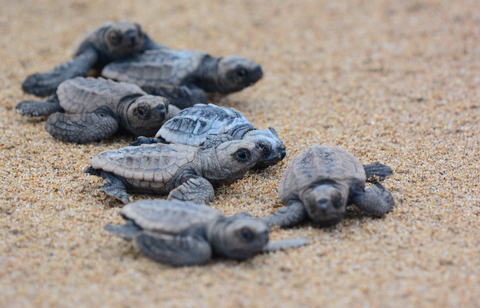

David Gofrey of partner STC carries rescued eggs into NASA
What a great example of collaboration. Those hatchlings surely would’ve died if the clutches had not been moved, right?
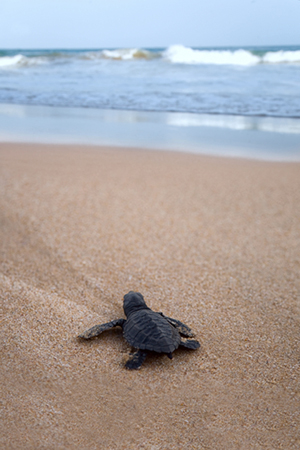 Those hatchlings had very little chance of avoiding oil if they entered the northern Gulf. That was the biggest part of the decision to undertake this translocation, which was no small feat. It took a small army and the commitment of partners throughout the southeast. That includes commercial partners, like FedEx, who donated their time and vehicles to move the clutches, and NASA, who provided their facility for the final weeks of incubation. For my career, it was the most integrated response effort I have ever been a part of.
Those hatchlings had very little chance of avoiding oil if they entered the northern Gulf. That was the biggest part of the decision to undertake this translocation, which was no small feat. It took a small army and the commitment of partners throughout the southeast. That includes commercial partners, like FedEx, who donated their time and vehicles to move the clutches, and NASA, who provided their facility for the final weeks of incubation. For my career, it was the most integrated response effort I have ever been a part of.

